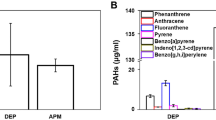Abstract
Particulate matter (PM) inhalation exposure affects exhaled CO2 concentration. Such exhaled CO2 refers to ventilation and perfusion of the cardiorespiratory system, the analysis of which is painless, non-invasive and simple to perform. This study examined the effect of prallethrin and d-phenothrin inhalation exposure on exhaled CO2 in mice using a simple method. Prallethrin and d-phenothrin were administered in male mice (Mus musculus) in a series of repeated inhalation exposures of lower and higher doses for 60 days. The lower dose was a mixture of 0.000141 mg/L prallethrin and 0.104 mg/L d-phenothrin, while the higher dose was a mixture of 0.00141 mg/L prallethrin and 1.04 mg/L d-phenothrin. The lower dose was based on a NOAEL value of prallethrin and d-phenothrin of 28 days exposure, while the higher one was ten times of the lower dose concentration. CO2 concentration was measured by means of the passage through NaOH 0.1 N, titrated by HCl 0.1 N. PMs were generated by the process of producing bubbles, inserted into the chamber containing mice. Mice were divided into four groups, namely: negative control (NC), positive control (PC), and lower- and higher-dose treatment groups, with three replicates for each group. Statistical difference analyses were observed in body weight and exhaled CO2 concentration between negative control and treatment groups, nevertheless, they did not differ significantly between the control and the treatment (lower and higher dose) groups. This study suggests that exhaled CO2 and body weight are not specific biomarkers to observe PMs inhalation exposure with respect to prallethrin and d-phenothrin mixtures.



Similar content being viewed by others
References
Abd-Elhady HK, Abou-Elghar GE (2013) Abamectin induced biochemical and histopathological changes in The Albino Rat, Rattus Norvegicus. J Plant Prot Res 53:263–270
Copping LG (2000) Metabolic pathways of agrochemicals: part two -insecticides and fungicides, eds-in-chief T Roberts and D Hutson, Royal Society of Chemistry, Cambridge, 1999, 1475 pp, price UK, 225 ISBN 085404 499 X. Pest Manag Sci 56:103–104
Park JH, Kwon J-T, Arassh M-T, Hwang S-K, Chang S-H, Lim HT, Cho H-S, Cho M-H (2010) Inhalation toxicity of particulate matters doped with arsenic induced genotoxicity and altered akt signaling pathway in lungs of mice. Toxicol Res 26:261–266
Lee J-S, Shin J-H, Lee J-O, Lee K-M, Kim J-H, Choi B-S (2010) Levels of exhaled breath condensate pH and fractional exhaled nitric oxide in retired coal miners. Toxicol Res 26:329–337
Kim JW, Park S, Lim CW, Lee K, Kim B (2014) The role of air pollutants in initiating liver disease. Toxicol Res 30:65–70
Kim C-W, Go R-E, Choi K-C (2015) Treatment of BG-1 ovarian cancer cells expressing estrogen receptors with lambda-cyhalothrin and cypermethrin caused a partial estrogenicity via an estrogen receptor-dependent pathway. Toxicol Res 31:331–337
Franck U, Odeh S, Wiedensohler A, Wehner B, Herbarth O (2011) The effect of particle size on cardiovascular disorders—the smaller the worse. Sci Total Environ 409:4217–4221
Beelen R, Raaschou-Nielsen O, Stafoggia M, Andersen ZJ, Weinmayr G, Hoffmann B, Wolf K, Samoli E, Fischer P, Nieuwenhuijsen M, Vineis P, Xun WW, Katsouyanni K, Dimakopoulou K, Oudin A, Forsberg B, Modig L, Havulinna AS, Lanki T, Turunen A, Oftedal B, Nystad W, Nafstad P, De Faire U, Pedersen NL, Östenson C-G, Fratiglioni L, Penell J, Korek M, Pershagen G, Eriksen KT, Overvad K, Ellermann T, Eeftens M, Peeters PH, Meliefste K, Wang M, Bueno-de-Mesquita B, Sugiri D, Krämer U, Heinrich J, de Hoogh K, Key T, Peters A, Hampel R, Concin H, Nagel G, Ineichen A, Schaffner E, Probst-Hensch N, Künzli N, Schindler C, Schikowski T, Adam M, Phuleria H, Vilier A, Clavel-Chapelon F, Declercq C, Grioni S, Krogh V, Tsai M-Y, Ricceri F, Sacerdote C, Galassi C, Migliore E, Ranzi A, Cesaroni G, Badaloni C, Forastiere F, Tamayo I, Amiano P, Dorronsoro M, Katsoulis M, Trichopoulou A, Brunekreef B, Hoek G (2013) Effects of long-term exposure to air pollution on natural-cause mortality: an analysis of 22 European cohorts within the multicentre ESCAPE project. Lancet 383:785–795
Mar TF, Norris GA, Koenig JQ, Larson TV (2000) Associations between air pollution and mortality in Phoenix, 1995–1997. Environ Health Perspect 108:347–353
Amann A, Poupart G, Telser S, Ledochowski M, Schmid A, Mechtcheriakov S (2004) Applications of breath gas analysis in medicine. Int J Mass Spectrom 239:227–233
Libardoni M, Stevens PT, Waite JH, Sacks R (2006) Analysis of human breath samples with a multi-bed sorption trap and comprehensive two-dimensional gas chromatography (GC × GC). J Chromatogr B 842:13–21
Prado C, Marı́n P, Periago JF (2003) Application of solid-phase microextraction and gas chromatography–mass spectrometry to the determination of volatile organic compounds in end-exhaled breath samples. J Chromatogr A 1011:125–134
Montuschi P, Nightingale JA, Kharitonov SA, Barnes PJ (2002) Ozone-induced increase in exhaled 8-isoprostane in healthy subjects is resistant to inhaled budesonide. Free Radic Biol Med 33:1403–1408
Siobal MS (2016) Monitoring exhaled carbon dioxide. Respir Care 61:1397–1416
Kivimagi I, Kuusik A, Ploomi A, Metspalu L, Jogar K, Williams IH, Sibul I, Hiiesaar K, Luik A, Mand M (2013) Gas exchange patterns in Platynus assimilis (Coleoptera: Carabidae): respiratory failure induced by a pyrethroid. Eur J Entomol 110:47–54
Kullmann T, Barta I, Lázár Z, Szili B, Barát E, Valyon M, Kollai M, Horváth I (2007) Exhaled breath condensate pH standardised for CO2 partial pressure. Eur Respir J 29:496–501
Kim D, Ghanayem BI (2006) Comparative metabolism and disposition of trichloroethylene in Cyp2e1−/− and wild-type mice. Drug Metab Dispos 34:2020–2027
WHO (2017) WHO specifications for pesticides used in public health. WHO, Washington
Rice E, Baird R, Eaton A, Clesceri L (1905) Standard methods for the examination of water and wastewater. American Water Works Association, Washington
Godin SJ, Scollon EJ, Hughes MF, Potter PM, DeVito MJ, Ross MK (2006) Species differences in the in vitro metabolism of deltamethrin and esfenvalerate: differential oxidative and hydrolytic metabolism by humans and rats. Drug Metab Dispos 34:1764–1771
US EPA O (1998) Series 870-health effects test guidelines OPPTS 870.1300 acute inhalation toxicity
Ventura LMB, Amaral BS, Wanderley KB, Godoy JM, Gioda A (2014) Validation method to determine metals in atmospheric particulate matter by inductively coupled plasma optical emission spectrometry. J Braz Chem Soc 25:1571–1582
Redgrave TG, Martins IJ, Mortimer B-C (1995) Measurement of expired carbon dioxide to assess the metabolism of remnant lipoproteins. J Lipid Res 36:2670–2675
US Department of Health and Human Services, Food and Drug Administration, Center for Drug Evaluation and Research (CDER), and Center for Veterinary Medicine (CVM) (2018) Bioanalytical method validation guidance for industry. Biopharmaceutics, Washington
Reeb-Whitaker CK, Paigen B, Beamer WG, Bronson RT, Churchill GA, Schweitzer IB, Myers DD (2001) The impact of reduced frequency of cage changes on the health of mice housed in ventilated cages. Lab Anim 35:58–73
Perkins SE, Lipman NS (1996) Evaluation of microenvironmental conditions and noise generation in three individually ventilated rodent caging systems and static isolator cages. Contemp Top Lab Anim Sci 35:61–65
Baker DG, Lipman NS, Anderson L, Otto G, Pritchett-Corning K, Whary M (2015) Factors that can influence animal research. In: Anderson L, Otto G, Pritchett-Corning K, Whary M (eds) Laboratory animal medicine. Elsevier, pp 1441–1496
Lawrence LJ, Casida JE (1982) Pyrethroid toxicology: mouse intracerebral structure-toxicity relationships. Pestic Biochem Physiol 18:9–14
Emond M, Faubert S, Perkins M (2003) Social conflict reduction program for male mice. Contemp Top Lab Anim Sci 42:24–26
D’Arbe M, Einstein R, Lavidis NA (2002) Stressful animal housing conditions and their potential effect on sympathetic neurotransmission in mice. Am J Physiol Integr Comp Physiol 282:R1422–R1428
Foltz C, Carbone L, DeLong D, Rollin BE, Van Loo P, Whitaker J, Wolff A (2007) Considerations for determining optimal mouse caging density. Lab Anim (NY) 36:40–49
Baer H (1971) Long-term isolation stress and its effects on drug response in rodents. Lab Anim Sci 21:341–349
Brain P (1975) What does individual housing mean to a mouse? Life Sci 16:187–200
Kramer K, van de Weerd H, Mulder A, Van Heijningen C, Baumans V, Remie R, Voss H-P, van Zutphen BFM (2004) Effect of conditioning on the increase of heart rate and body temperature provoked by handling in the mouse. Altern Lab Anim 32 Suppl 1A:177–181
Obernier JA, Baldwin RL (2006) Establishing an appropriate period of acclimatization following transportation of laboratory animals. ILAR J 47:364–369
Albaum HG, Tepperman J, Bodansky O (1946) The in vivo inactivation by cyanide of brain cytochrome oxidase and its effect on glycolysis and on the high energy phosphorus compounds in brain. J Biol Chem 164:45–51
Vallero DA (2007) Fundamentals of air pollution, 4th edn. Elsevier, Amsterdam, pp 1–15
Kulkarni P, Baron PA, Willeke K (2011) Introduction to aerosol characterization. Aerosol measurement. Wiley, Hoboken, pp 1–13
Owen M, Ensor D, Sparks L (1992) Airborne particle sizes and sources found in indoor air. Atmos Environ Part A Gen Top 26:2149–2162
Phalen RF, Hinds WC, John W, Lioy PJ, Lippmann M, McCawley MA, Raabe OG, Soderholm SC, Stuart BO (1986) Rationale and recommendations for particle size-selective sampling in the workplace. Appl Ind Hyg 1:3–14
Santiasih I, Hermana J (2017) A review: the physicochemical characteristics of indoor particulate matters in relation to human health. ARPN J Eng Appl Sci 12:1813–1821
Cole LM, Ruzo LO, Wood EJ, Casida JE (1982) Pyrethroid metabolism: comparative fate in rats of tralomethrin, tralocythrin, deltamethrin, and (1R, alpha S)-cis-cypermethrin. J Agric Food Chem 30:631–636
Heudorf U, Angerer J (2001) Metabolites of pyrethroid insecticides in urine specimens: current exposure in an urban population in Germany. Environ Health Perspect 109:213–217
Ahmed AE, Loh JP, Ghanayem B, Hussein GI (1992) Studies on the mechanism of acetonitrile toxicity. I: whole body autoradiographic distribution and macromolecular interaction of 2-14C-acetonitrile in mice. Pharmacol Toxicol 70:322–330
Acknowledgements
This work is supported by a Research Grants Doctoral Dissertation, Ministry of Research, Technology and Higher Education of the Republic of Indonesia 2018, the agreement letter number 1678.2/PL19/LT/2018.
Author information
Authors and Affiliations
Corresponding author
Ethics declarations
Conflict of interest
The authors declare that there are no conflicts of interest.
Rights and permissions
About this article
Cite this article
Santiasih, I., Titah, H.S. & Hermana, J. The effects of particulate matters inhalation exposures of prallethrin and d-phenothrin mixture in mice (Mus musculus) against exhaled carbon dioxide concentration. Toxicol Res. 36, 59–67 (2020). https://doi.org/10.1007/s43188-019-00002-8
Received:
Revised:
Accepted:
Published:
Issue Date:
DOI: https://doi.org/10.1007/s43188-019-00002-8




